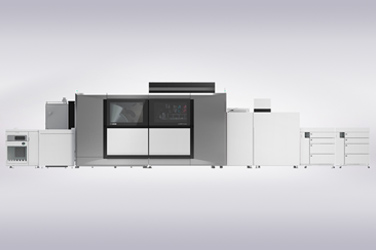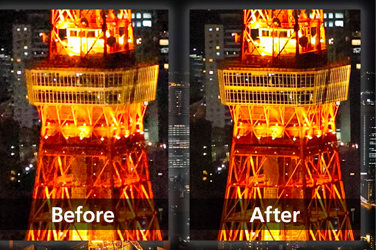

The advent of a new age in which cameras demonstrate their true potential
These days, HDR (High Dynamic Range) has become a commonly-used term. It is a technology that faithfully reproduces images how we see with the naked eye, without blown highlights or crushed shadows, and usually works by merging the best parts of three consecutive exposures to form a final image. However, what Canon aims to achieve is next-generation HDR technology that captures, displays and prints immeasurably realistic images that make the viewer feel as though they are seeing the actual scene with their own eyes—in other words, a technology that revolutionizes imaging conventions.
December 26, 2019Featured Technology
Recreating distant places through realistic imaging
It has been more than two decades since digital cameras became commonplace. Today, these imaging devices have evolved and are now capable of capturing a more diverse range of light information. However, until now, such output devices as PC monitors and printers had limited expressive capabilities and were thus unable to effectively convey the world as seen through the eyes of the user.
The advancement of monitors in recent years has encouraged the widespread use of HDR in movie making, as HDR enables high-contrast video expression.
As a leader in imaging technology, Canon is currently developing next-generation HDR technologies that improves how well monitors and printers reproduce the various brightness and color values that the camera records to produce realistic photos, further expanding the scope of photographic expression.
Taking full advantage of RAW data
Cameras today are capable of capturing most of the brightness information from a scene in a single image file, even when the subject is backlit and in other scenes with a lot of dynamic range—the range of brightness between the brightest and darkest parts of an image. However, the conventional format employed for displaying image data is SDR (Standard Dynamic Range), which supports only a narrow dynamic range.
Despite the advancements that make it possible for cameras to capture data with a higher dynamic range, it was previously impossible to fully showcase their performance as the images ended up being converted to an SDR format. Devices such as smartphones employ an HDR technique that captures and combines multiple (usually three) exposures with different brightness settings. However, this involves merging images originally captured in an SDR format, which simply squeezes tonal information (color contrast and brightness) into the narrow dynamic range of a given output device. This method tends to produce unnatural results and is unsuitable for capturing moving objects.
Conversely, Canon next-generation HDR technology saves the wide dynamic range of the original (RAW) data captured by the camera in an HDR-compatible format, which can be reproduced on an HDR-supported monitor or in HDR printing. With this next-generation HDR workflow that connects the entire process from input to output using HDR data, Canon has succeeded in utilizing the abundant information contained in the RAW data for outputting still images that look substantially more realistic than before.
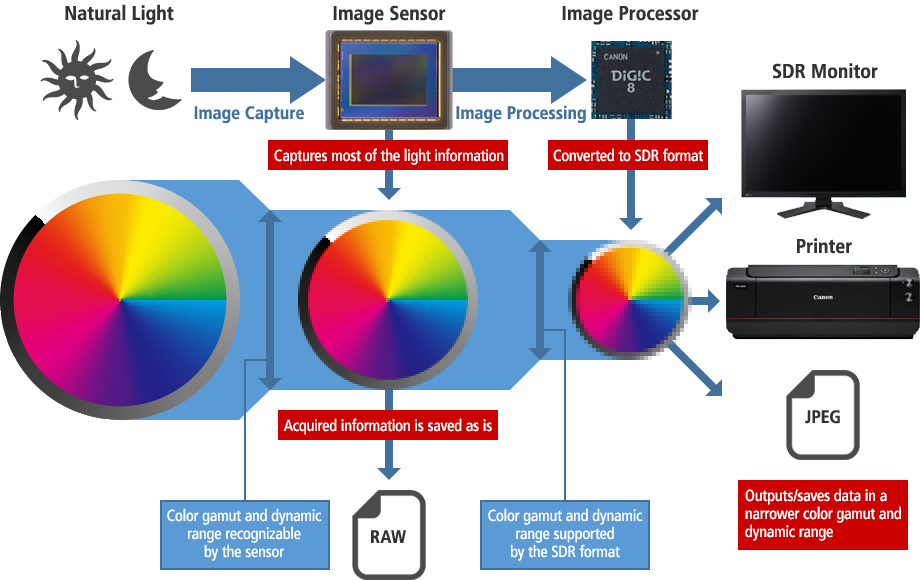
How SDR works
Next-generation HDR turns conventional imaging on its head
Currently, with advancements in reference display technology, there are two HDR systems that are gaining widespread popularity: PQ and HLG, both of which utilize ITU-R BT.2100 recommendations. Canon professional cameras and reference displays for video production are compatible with both systems, while Canon’s next-generation HDR technology for still photography employs PQ.
The PQ system defines peak brightness as an absolute value, thus enabling display at a constant level of brightness. Unlike the HLG system where the peak brightness varies with the display device in use, the PQ system allows for a level of reproduction that meets the needs of professional photographers. Employing the PQ system, Canon’s next-generation HDR technology is able to offer excellent reproducibility during photo-editing.
The PQ format supports brightness output up to 10,000 nits (cd/m²)*, 100 times higher than conventional SDR formats, where peak brightness is set at 100 nits. In other words, as long as a high-luminance display device is used, it is possible to display data without having to narrow the dynamic range obtained by the digital camera.
- *Nit: Unit of luminance
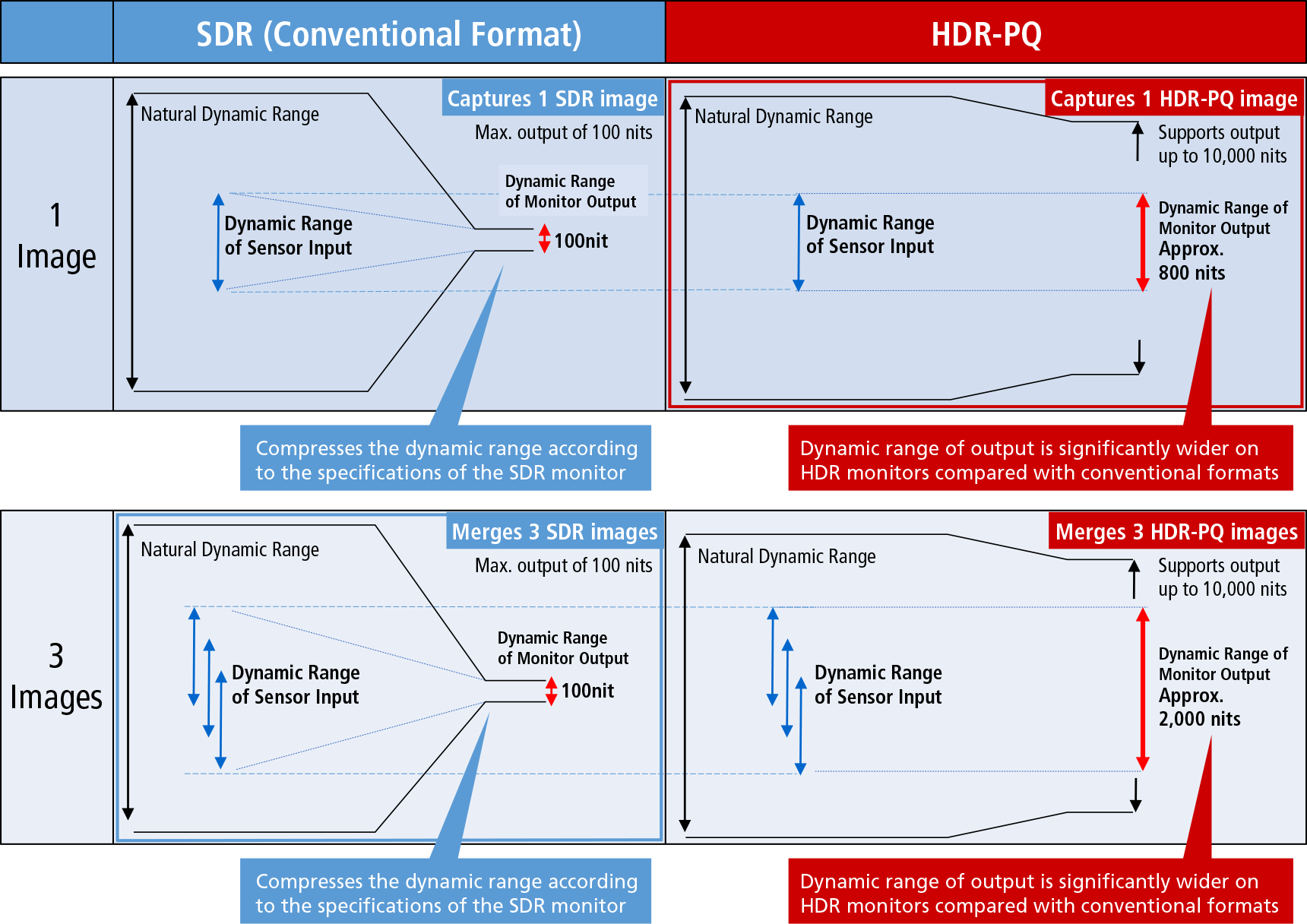
Comparison of SDR and HDR-PQ
In addition to expanding the displayable luminance range, Canon’s next-generation HDR technology also helps to enhance the reproduction of colors and gradation. The HEIF format has been adopted in place of the conventional JPEG format for capturing still images. Compared with the 8 bits (256-level greyscale) of the JPEG format, HEIF is capable of storing image data at 10 bits (1024-level greyscale) or higher, and also supports the Rec. 2020 standard*, which boasts an extremely wide color gamut. What’s more, HEIF is compatible with the HEVC (H.265)* codec, which offers a higher compression efficiency in storage compared with JPEG* files of the same image quality.
All the above make it possible to achieve more realistic still images that closely resemble what we see with the naked eye.
- *Rec. 2020: Color gamut specification that is the standard for 8K HD broadcast.
- *HEVC (H.265): The most advanced image compression standard adopted by the ITU-T, an international organization for standardization.
- *JPEG: A compression format for still image data. It offers a high compression rate with slight deterioration in image quality.
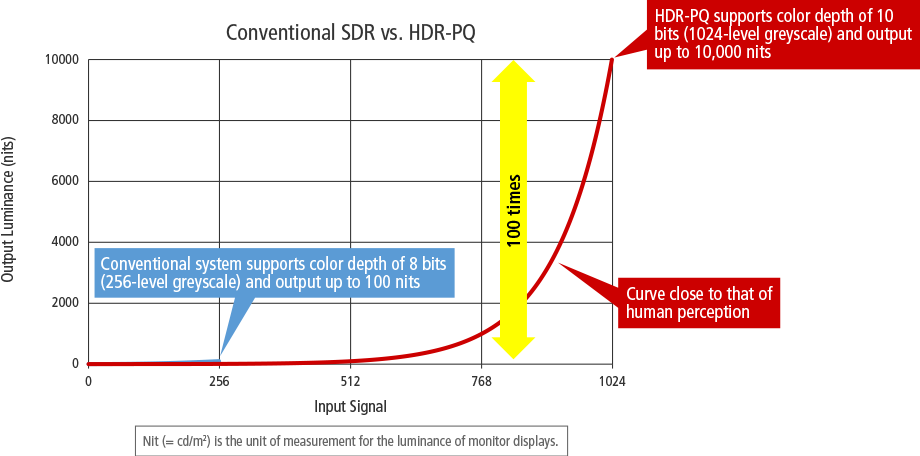
HDR format: ITU-R BT.2100 (PQ)
Color depth: 10 bits
Color sampling: 4:2:2
Color gamut: Supports BT.2020
File format: HEIF
Compression format: HEVC (H.265)
Specifications
Recreate realistic looking scenes without retouching from memory.
With Canon’s next-generation HDR workflow, still images that are produced in an HDR format deliver a realistic feel that closely resembles what we see through the naked eye. In the past, it was possible to reproduce images in the SDR format that were somewhat close to the real thing employing advanced touch-up (image correction) techniques to render scenes with stark differences in brightness as they were in real life from memory. However, employing next-generation HDR technology, anyone can produce true-to-life images without having to retouch them from memory.
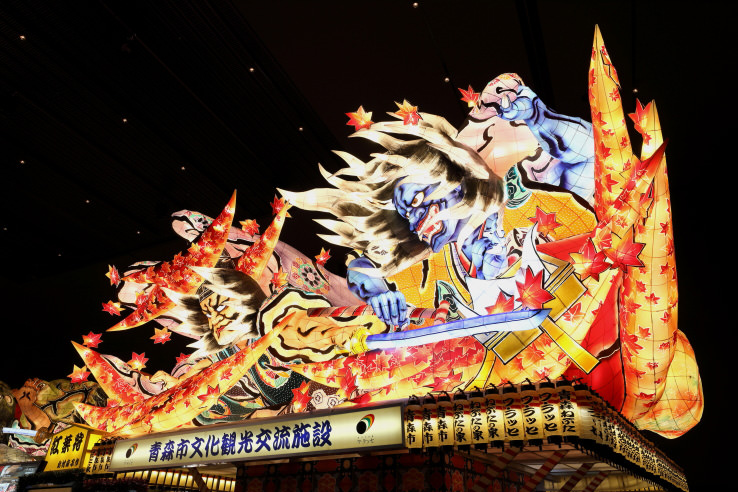

SDR
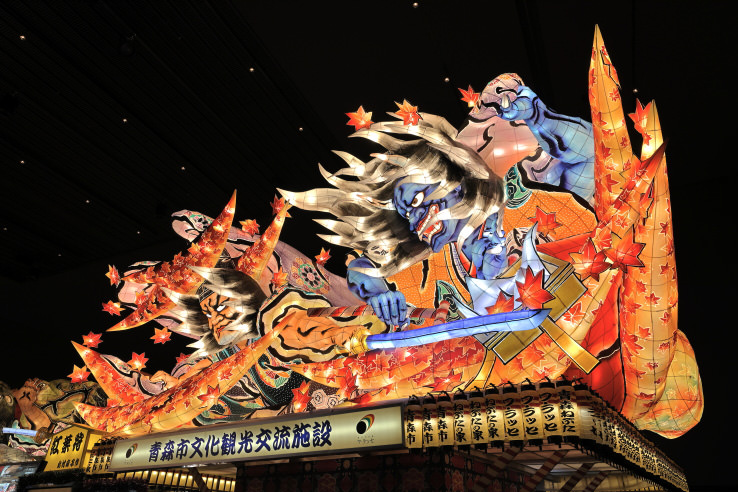

HDR
- *These images simulate HDR on SDR displays.
4K HDR Reference Displays demonstrate their true potential
One key factor behind Canon’s development of next-generation HDR technology is the in-house production of a high-performance 4K HDR reference displays. Canon’s 4K HDR reference displays exceed the standard luminance for HDR specifications (ITU-R BT.2100), a peak brightness of 1,000 cd/m² or higher and a black luminance level of 0.005 cd/m² or lower. The DP-V3120, which launched in November 2019, delivers a full-screen white (maximum) luminance level of 2,000 cd/m² and a black (minimum) luminance level of 0.001 cd/m² with a high contrast of 200000:1, and meets the “Preferred” level of requirements under Dolby Vision Ver. 1.3. From the perspective of technological evolution, Canon’s success in commercializing displays that enable the accurate expression of camera images also holds great significance for the company’s entire image production process.

4K HDR Reference Displays
Reproducing HDR in print
While it is possible to express high luminance using back illumination when displaying HDR images on a monitor, reproducing the contrast in brightness can be a challenging task in print, where colors are expressed through reflected light. In order to leverage the advantages of HDR images in printing, which has a narrow luminance range, Canon engaged in efforts to develop a new dynamic range compression algorithm to replace the traditional simple gamma conversion system.

How HDR print works
With new dynamic range compression techniques, the characteristics of human vision are turned into an algorithm that makes use of both information on the dynamic range of each captured image as well as that of each printing paper type. Furthermore, by introducing an image analysis technique, Canon also succeeded in automatically generating the optimal gamma conversion curve (a tonal gradient that matches human visual characteristics) for each image. This technology is what sets Canon apart, with its expertise in both input and output devices that it has accumulated over the years.
Unlike displays, which express colors through the light they emits, printing expressing colors using reflected light, which makes it difficult for it to express a wide range of colors from such extremely bright tones as sunlight to such extremely dark tones as those inside a cave. However, thanks to the success in reproducing a tonal gradient close to that of perceived by human vision, it is now possible to produce prints with color tones that are close to the way we actually see the world, even under normal lighting, without the need to apply special retouching to the print data.
The imagePROGRAF PRO series of inkjet printers is popular among professional photographers for HDR printing. With conventional inks, blacks can sometimes appear faint under bright lighting, and thus unable to convey a wide dynamic range. LUCIA PRO ink, however, boasts excellent reproduction of blacks that don’t appear faint under bright lighting, enabling the expression of a wide dynamic range. Furthermore, HDR prints can be optimized according to the brightness of the lighting at the exhibition venue using the Exhibition Lighting Optimization function of Canon Professional Print & Layout software, so HDR images that offer a true-to-life representation of their subject can be printed out for viewing.
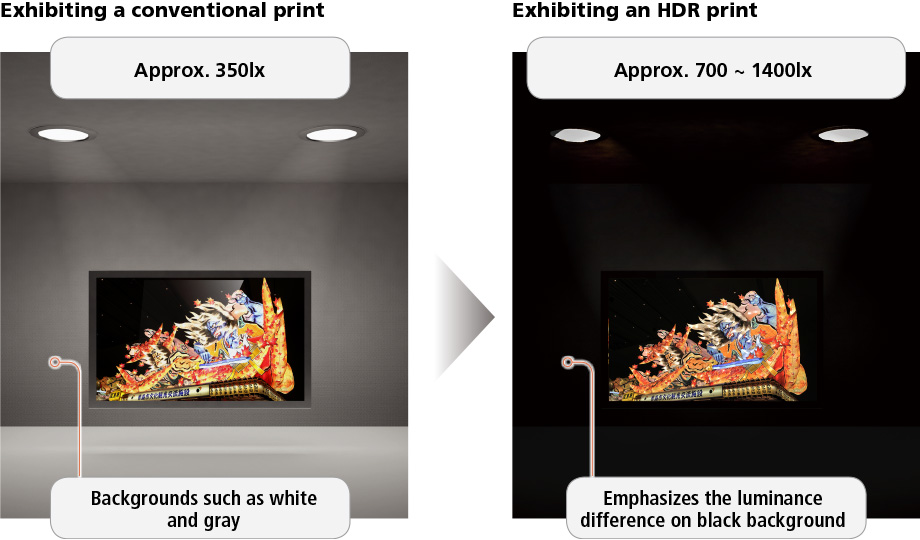
Optimizing HDR prints for exhibition lighting
More and more products support next-generation HDR workflows
With a camera that supports next-generation HDR, such as the EOS R, HDR images can be developed from RAW data inside the camera and displayed on an HDR display using just an HDMI cable. What’s more, using Canon’s Digital Photo Professional (DPP) RAW development software allows HDR development and output to be performed on a PC. Additionally, Professional Print & Layout printing software enhances the link between camera and printer, making HDR printing possible using an imagePROGRAF PRO series printer.

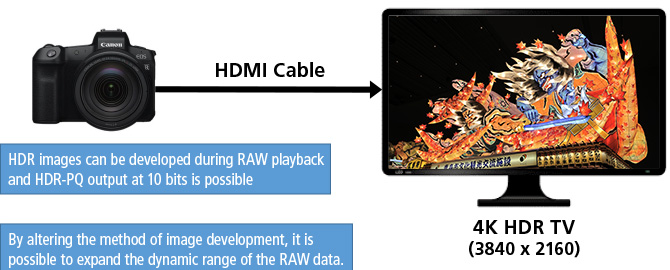
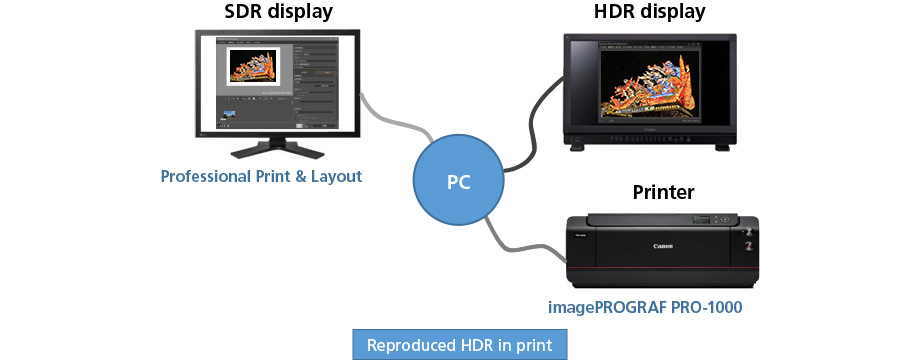

The workflow of next-generation HDR
Next-generation HDR that opens up new avenues for photographic expression
RAW data captured using an EOS camera contains a vast amount of light information that, in the past, could not be expressed by displays or in print. Next-generation HDR technology and advancements in display technology may soon unlock the true potential of cameras, allowing users to achieve photographic expression that realistically depicts the reality of what they see when shooting.
Canon will continue to expand its lineup of products that support next-generation HDR technology while proposing frameworks for new means of photographic expression.


